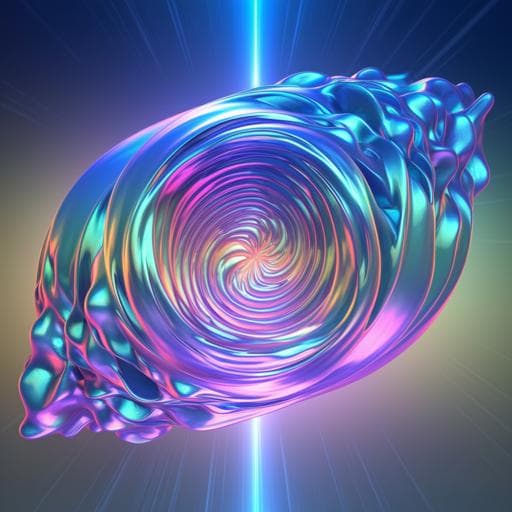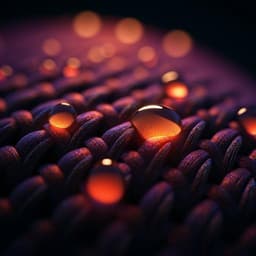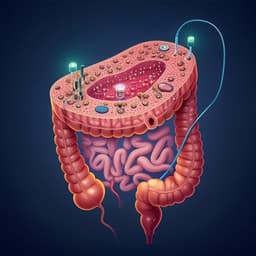
Engineering and Technology
Geometric phase-encoded stimuli-responsive cholesteric liquid crystals for visualizing real-time remote monitoring: humidity sensing as a proof of concept
S. Li, Z. Chen, et al.
Discover an innovative visual sensing platform designed by Shi-Long Li and colleagues, harnessing the unique properties of cholesteric liquid crystal polymers to create real-time visual patterns. This groundbreaking research showcases how humidity-responsive films can dynamically alter vortex beams, paving the way for advanced remote humidity monitoring solutions.
~3 min • Beginner • English
Introduction
Sensing technologies are increasingly important across biology, medicine, chemical industry, communication, and aerospace, driven by needs for environmental safety, rapid information acquisition, and high-precision data processing. Stimuli-responsive photonic crystals, particularly cholesteric liquid crystals (CLCs), are attractive for optical sensing due to their self-assembled helical superstructures, facile fabrication of one-dimensional photonic crystal structures, and vivid structural colors from Bragg reflection. The reflection band under normal incidence depends on the ordinary and extraordinary refractive indices and the cholesteric pitch, enabling visible color changes. Prior work has shown CLCs are responsive to a variety of external stimuli (light, temperature, humidity, strain, pH) and analytes (organic vapors, alcohols, amines, metal ions). Despite producing visible signals, precise readout typically requires spectrometers, limiting practical deployment. Concurrently, planar optical elements leveraging geometric (Pancharatnam-Berry) phase arising from spin-orbit interaction in anisotropic media like liquid crystals have advanced rapidly. Since 2016, circularly polarized Bragg-reflected light from planar CLCs has been shown to acquire geometric phase; by spatially varying the CLC helical axis, this phase can be engineered within the photonic band gap, enabling broadband reflective devices (deflectors, lenses, Airy beams, vortex generators). Geometric-phase-encoded planar CLCs can modulate the reflected diffracted light field across wavelengths, offering image-based sensing beyond wavelength/frequency readouts. Optical vortex beams (carrying orbital angular momentum) provide robustness and stability during transmission, suggesting potential for remote sensing in environments where traditional sensors struggle (hazardous chemicals, high-altitude weather, aerospace). This work proposes a visual sensing platform utilizing geometric phase encoding in stimuli-responsive cholesteric liquid crystal polymers (CLCPs) to deliver real-time sensing via visual patterns rather than frequency shifts. As a proof of concept, a humidity-responsive CLCP q-plate encodes relative humidity into changes of the reflected vortex beam morphology. The platform further demonstrates extended-range monitoring using a four-quadrant q-plate array and a dual-wavelength approach, and enables remote sensing by exploiting the directionality and long-range propagation of vortex laser beams.
Literature Review
Stimuli-responsive photonic crystals enable battery-free structural color sensing. Cholesteric liquid crystals are particularly compelling due to their one-dimensional photonic band gap and tunable helical pitch, yielding Bragg reflections across the visible spectrum. A broad body of work reports CLC-based sensors responsive to light, temperature, humidity, strain, pH, and to chemical analytes such as organic vapors, alcohols, amines, and metal ions. However, precise quantification typically requires spectrometers to measure wavelength shifts, hampering practicality. In parallel, geometric (Pancharatnam-Berry) phase optics in liquid crystals has matured: spin-orbit coupling-induced geometric phases in circularly polarized Bragg reflection from planar CLCs have been demonstrated, and spatial control of the helical axis has been used to realize reflective planar optical elements (deflectors, lenses, Airy beams, and optical vortex generators) that can operate over polychromatic bands. Geometric phase encoding in CLC devices can produce diffracted light fields that vary across the reflection band, yielding rich image-based data streams. Optical vortex beams carrying orbital angular momentum are stable in transmission and provide an additional degree of freedom that can be exploited for robust, potentially remote sensing, especially in challenging environments where conventional optical sensors may fail.
Methodology
Materials and film design: A humidity-responsive CLCP system was formulated from reactive mesogens (M1–M4), photoinitiator Irgacure 651, and a right-handed chiral dopant R5011. M4 is non-polymerizable and serves to swell the network, later removed via alkaline treatment. The uncured mixture exhibits thermochromic behavior; by adjusting curing temperature (e.g., 65 °C), the initial photonic band gap can be tailored. Fabrication and geometric phase encoding: Photoalignment layers (SD1) were coated on both inner sides of an ITO-glass cell. A q-plate pattern was recorded using 405 nm linearly polarized light; SD1 molecules align with the incident polarization via dichroic absorption, defining a spatially varying director pattern. The CLC mixture was then filled into the cell in the isotropic state by capillary action. The CLC adopted the patterned orientation via intermolecular interactions and self-assembly. The film was polymerized by UV exposure at an appropriate temperature. Post-processing: The top substrate with the attached CLCP film was peeled off and immersed in 0.1 M KOH for 15 minutes. Base treatment converted carboxylic acids to carboxylate salts, disrupting hydrogen bonds and yielding a hygroscopic polymer salt with a broadened tunable reflection range. Films were rinsed and dried under nitrogen, producing humidity-responsive CLCP films encoded with geometric phase (q-plate) patterns. Optical characterization and humidity control: Films cured at 65 °C were tested in a humidity-controlled environment (RH 10%–95%). Reflection spectra were recorded, showing band shifts with RH. Polarizing optical microscopy documented structural color changes with RH. Single-wavelength sensing demonstration: A 632.8 nm He–Ne laser (RCP incidence matching the CLC handedness) probed the reflective diffraction from a single q-plate (q = +0.5). The experimental setup included mirrors, attenuator, quarter-wave plate, beam splitters, and a cylindrical lens, with reflected patterns captured on CCD cameras. Far-field intensity profiles of the reflected vortex beam were recorded while sweeping RH, and the morphology/brightness of vortex beams and light spots were analyzed (including areas of dark cores and bright spots).
Key Findings
– The central reflection band of the humidity-responsive q-plate-encoded CLCP films red-shifted from 581 nm to 719 nm as RH increased from 10% to 95%, while maintaining a consistent photonic band gap profile. – Below ~40% RH, negligible band shift and faint reflected intensity were observed, attributed to low dew point and insufficient water uptake; at 25 °C and 40% RH, dew point ≈ 10.47 °C, implying unsaturated air and minimal film swelling. – Films exhibited reversible and repeatable humidity response with stability over at least two months under ambient storage. – For a single q-plate (q = +0.5) probed at 632.8 nm (RCP): the reflected vortex beam (VB) morphology changed with RH. From 40%–86% RH, diffracted field brightness increased as the reflection band approached the probe wavelength; optimal VB quality occurred around 73%–86% RH where the band overlapped 632.8 nm; above ~86% RH, VB quality decreased as the probe wavelength moved out of the band. – Visual, real-time sensing was achieved by monitoring VB patterns (dark core and light spot morphology/area) rather than measuring wavelength shifts. – The approach is compatible with remote monitoring due to the high directionality and long-range transmission of vortex laser beams; the authors also outline extended schemes including a four-quadrant q-plate array and dual-wavelength monitoring to broaden sensing range.
Discussion
The results demonstrate that encoding geometric phase into a humidity-responsive CLCP enables direct visual readout of environmental humidity through the morphology of reflected vortex beams, addressing the practical limitation of CLC sensors that typically require spectrometers for wavelength tracking. The strong red shift of the reflection band with increasing RH stems from hygroscopic swelling of the polymer salt network, which increases the cholesteric pitch. By aligning the probe wavelength with the humidity-tunable photonic band gap, the reflected vortex beam quality becomes a robust proxy for RH. The use of orbital angular momentum provides an additional degree of freedom and robust far-field patterns that are stable during propagation, paving the way for real-time, long-distance humidity monitoring in scenarios unsuitable for conventional sensors. The platform maintains the broadband reflective benefits of CLC-based planar optical elements and converts stimulus-induced band shifts into easily recognizable, image-based signals. Limitations such as reduced sensitivity below ~40% RH (dew-point limited uptake) and the requirement for handedness-matched circular polarization can be managed through initial band tailoring (via curing temperature), multi-wavelength probing, or patterned arrays to extend dynamic range.
Conclusion
This work introduces a geometric phase-encoded, stimuli-responsive CLCP platform that converts humidity-induced photonic band shifts into real-time, recognizable visual patterns of reflected vortex beams, eliminating the need for spectrometric readout. The films exhibit large, reversible humidity tunability (581–719 nm across 10%–95% RH), stable operation, and compatibility with remote sensing owing to the directionality and propagation robustness of OAM beams. The approach broadens the application landscape of CLCP-based broadband reflective planar optical elements from photonics into practical sensing. Future directions include optimization for low-RH sensitivity (e.g., via material formulations or environmental conditioning), expansion to other stimuli (temperature, strain, pH, chemical analytes), integration of multi-wavelength or multiplexed q-plate arrays for wider dynamic ranges and multi-parameter sensing, and deployment in field-ready, compact systems for environmental and industrial monitoring.
Limitations
– Diminished responsiveness below ~40% RH due to low dew point and insufficient water condensation/uptake, leading to negligible band shifts and weaker visual signals. – Requirement for circular polarization matching the handedness of the CLC to maximize Bragg reflection and geometric phase effects. – Dependence on a coherent laser probe and alignment-sensitive optical setup for optimal vortex beam readout. – The provided data focus on a single probe wavelength (632.8 nm) and a specific curing temperature (65 °C); broader calibration across wavelengths and fabrication conditions is needed for generalized deployment. – Full multi-affiliation and device packaging details are not included in the excerpt; environmental robustness (e.g., temperature fluctuations, mechanical durability) and long-term cycling beyond two months require further validation.
Related Publications
Explore these studies to deepen your understanding of the subject.







